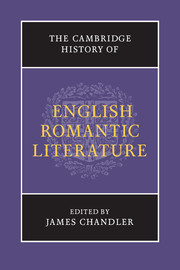
- Cited by 7
-
Cited byCrossref Citations
This Book has been cited by the following publications. This list is generated based on data provided by Crossref.
2009. Books of Critical Interest. Critical Inquiry, Vol. 35, Issue. 4, p. 1092.
Humphreys, Stephen and Otomo, Yoriko 2014. Theorising International Environmental Law. SSRN Electronic Journal,
Looser, Devoney 2015. The Cambridge Companion to Women's Writing in the Romantic Period.
2017. The Romantic Poetry Handbook. p. 325.
2018. Musizierende »Wunderkinder«. p. 449.
Saglia, Diego 2018. European Literatures in Britain, 1815–1832: Romantic Translations.
Clark, Steve 2019. British Romanticism in Asia. p. 387.
- Publisher:
- Cambridge University Press
- Online publication date:
- May 2009
- Print publication year:
- 2009
- Online ISBN:
- 9781139055970




